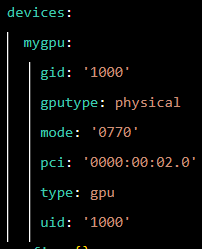I can’t seem to get HW accelerated graphics despite passing my gpu.
Operating System: Fedora Linux 40 (Container Image)
Kernel: Linux 6.8.5-301.fc40.x86_64
incus config show -e dmain | grep -C 1 'type: gpu':
mygpu:
type: gpu
ll /dev/dri:
total 0
crw-rw----. 1 root root 226, 1 Dec 24 12:53 card1
crw-rw-rw-. 1 root root 226, 128 Dec 24 12:53 renderD128
I have a bunch of mesa stuff installed which were pulled by @cinnamon-desktop; dnf list --installed | grep mesa:
mesa-dri-drivers.x86_64 24.1.7-1.fc40 @updates
mesa-filesystem.x86_64 24.1.7-1.fc40 @updates
mesa-libEGL.x86_64 24.1.7-1.fc40 @updates
mesa-libGL.x86_64 24.1.7-1.fc40 @updates
mesa-libGLU.x86_64 9.0.3-4.fc40 @fedora
mesa-libOSMesa.x86_64 24.1.7-1.fc40 @updates
mesa-libgbm.x86_64 24.1.7-1.fc40 @updates
mesa-libglapi.x86_64 24.1.7-1.fc40 @updates
mesa-va-drivers.x86_64 24.1.7-1.fc40 @updates
mesa-vulkan-drivers.x86_64 24.1.7-1.fc40 @updates
glxinfo -display :1001 -B output; the display is set up by NoMachine (I got the same result with xpra):
name of display: :1001
display: :1001 screen: 0
direct rendering: Yes
Extended renderer info (GLX_MESA_query_renderer):
Vendor: Mesa (0xffffffff)
Device: llvmpipe (LLVM 18.1.6, 256 bits) (0xffffffff)
Version: 24.1.7
Accelerated: no
Video memory: 15930MB
Unified memory: yes
Preferred profile: core (0x1)
Max core profile version: 4.5
Max compat profile version: 4.5
Max GLES1 profile version: 1.1
Max GLES[23] profile version: 3.2
Memory info (GL_ATI_meminfo):
VBO free memory - total: 21 MB, largest block: 21 MB
VBO free aux. memory - total: 14483 MB, largest block: 14483 MB
Texture free memory - total: 21 MB, largest block: 21 MB
Texture free aux. memory - total: 14483 MB, largest block: 14483 MB
Renderbuffer free memory - total: 21 MB, largest block: 21 MB
Renderbuffer free aux. memory - total: 14483 MB, largest block: 14483 MB
Memory info (GL_NVX_gpu_memory_info):
Dedicated video memory: 4294224127 MB
Total available memory: 4294240057 MB
Currently available dedicated video memory: 21 MB
OpenGL vendor string: Mesa
OpenGL renderer string: llvmpipe (LLVM 18.1.6, 256 bits)
OpenGL core profile version string: 4.5 (Core Profile) Mesa 24.1.7
OpenGL core profile shading language version string: 4.50
OpenGL core profile context flags: (none)
OpenGL core profile profile mask: core profile
OpenGL version string: 4.5 (Compatibility Profile) Mesa 24.1.7
OpenGL shading language version string: 4.50
OpenGL context flags: (none)
OpenGL profile mask: compatibility profile
OpenGL ES profile version string: OpenGL ES 3.2 Mesa 24.1.7
OpenGL ES profile shading language version string: OpenGL ES GLSL ES 3.20
I get llvmpipe software rendering, not good.
I use X11 and Cinnamon. I honestly don’t know how NoMachine knows how to start Cinnamon but it does. grep -iR cinnamon /etc/x11 gives nothing.
Could this be an X11 issue or what?
(related but only slightly: Run Offline TTS with AMD GPU Acceleration in an Incus Container)

